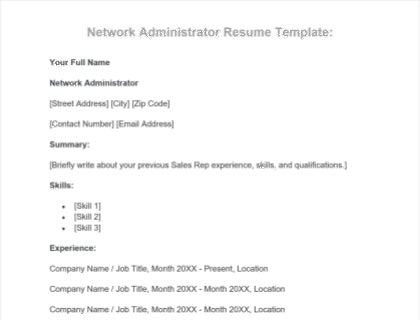
Network Administrator Resume Free Template
Download this network administrator resume template in Microsoft Word format and start using it straight away.
Download NowNetwork Administrator Resume Example:
Your Name
Network Administrator
[Link to website/ online portfolio / LinkedIn profile]
[Street address]
[City]
[Zip code]
[Contact number]
[Email address]
Summary:
[Briefly talk about your background, skills, and qualifications.]
Key Skills:
- [Skill 1]
- [Skill 2]
Experience:
Company Name / Job Title
Month 20XX - Present, Location
Company Name / Job Title
Month 20XX - Month 20XX, Location
Company Name / Job Title
Month 20XX - Month 20XX, Location
Education:
School Name / Degree
Month 20XX - Month 20XX, Location
School Name / Degree
Month 20XX - Month 20XX, Location
Certifications:
- [Certification 1]
- [Certification 2]
Notable Achievements:
- [Achievement 1]
- [Achievement 2]
Awards:
- [Award 1]
- [Award 2]
How to Write a Network Administrator Resume:

A step-by-step guide to writing the perfect network administrator resume.
Start with a summary.
Make your summary stand out.

You'll want your summary to create a lasting impression, intriguing employers enough to continue reading your resume. Start by highlighting your most desirable qualities including your skills, years of experience, and greatest accomplishments.
Keep your summary short and to the point.

Try to keep your summary under four sentences and only include the most pertinent information. Add a sentence about how your specific skill set and experience will benefit the employer's organization.
List your technical skills.
Start with your most important skills.

Your core network administration skills with virtualization, LAN/WAN connections, system administration, firewalls, switches, etc., should be mentioned first. Be sure to mention all relevant skills that could set you apart from other candidates.
Match your skill set with the job posting.

You'll want to list all relevant skills and competencies you have acquired over time. Directly match your skills with the job requirements. Do not list skills that will not be needed for the position.
Be honest.

When listing your competencies, remain honest about your level of expertise as the hiring process may require practical assessments.
Showcase your experience.
List your work history in reverse chronological order.

The work experience section is an imperative part of your resume as employers will want to read about the experience that you gained with network administration at previous positions. You'll want to start this section with your most recent position.
Add the places you have worked.

Include the name of each employer, your role, how long you worked there, and where the company is located. Use bullet points to list the tasks and responsibilities for each position.
Be sure to pay special attention to the type of responsibilities you managed at previous jobs. This will help employers envision you in the role and determine the type of tasks you're knowledgeable in.
Outline your education information.
Add your qualifications.

In reverse chronological order, list your qualifications, each with an institution name, the dates of attendance, and a location.
Mention qualifications in progress.

If you're studying towards a qualification, be sure to indicate it at the start of this section. Omit the initial date and instead include the words "In Progress."
Include your certifications.
List any relevant certificates.

While your portfolio of projects already says a lot about you and your abilities, to help improve your chances of an interview, consider adding relevant certifications, even if not required.
Start with your most relevant certificate.

If you obtained more than one certificate, consider which one employers would be most interested in and mention it first.
Common certificates related to network administration include:
- CompTIA A+ Certification.
- CompTIA Network+.
- CompTIA Security+.
- Cisco CCNA.
- MCSA.
Add certification details.

Remember to mention the institution and the date you obtained your certification. Certificates awarded by prestigious institutions indicate to employers that you have formal training and that you're passionate about your job.
Highlight your career achievements.
Highlight any major completed projects.

Your career milestones are a great addition to your resume because they act as solid references, proving to employers that you're more than capable of exceeding their expectations.
Provide only the most relevant details about your achievements, e.g. those related to optimized network reliability, scalability, security, data confidentiality, and/or system integrity.
Include actual measurements, for example, that you maintained 60+ computers in a mixed server environment (Windows/Unix/Linux) and consistently achieved an uptime of 99.9% or better.
List any awards and job promotions.
List key career moments at the end of your resume.

These typically include professional awards and job promotions that may be of particular interest to employers.
Provide the details of your awards or promotions.

Use bullet points to briefly describe each entry and list them in reverse chronological order. Remember that each point should also identify the institution/employer and don't neglect to provide a date.


